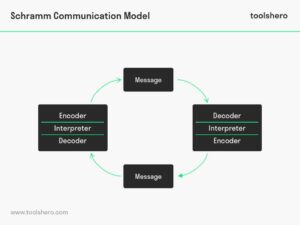Schramm Communication Model

Schramm Communication Model: this article provides a practical explanation of the Schramm Communication Model. After reading, you will have a basic understanding of this powerful communication tool.
What is the Schramm Communication Model?
The Schramm Communication Model is a cyclical communication model containing all basic principles of communication. The Schramm Communication Model offers a classic approach to and explanation of communication. It can be used to determine how communication between two people works when they’re exchanging information, ideas, or attitudes.
The cyclical communication model is based on the theory and belief that communication is a two-way street. This means there’s at least a sender and a recipient. The model contains at least one other element as well; the message itself. Usually communication takes places along the traditional path with a wasteful recipient and sender.
The recipient and sender can also be one and the same. This is called intra-personal communication. The former is called interpersonal communication. Where several other models and theories about communication are linear in nature, the Schramm Communication Model is circular. This means at least two parties are required to send and receive a message. Both the sender and the recipient have to encode and decode the message to interpret the message correctly.
Wilbur Schramm published the circular communication model in 1954, several years after Lasswell’s communication model was published.
Schramm wrote and spoke about the communication model—based on the model by Charles Egerton Osgood—in his book ‘The Process and Effects of Mass Communication’.
He later made some changes, including introducing the field of experience, or commonality. This refers to what is mutually understood between the recipient and the sender. A physics professor can teach mathematical principles to a class of psychology students, but it won’t be easy as the students don’t share a field of experience that would have made it easier to understand the message.
Three Elements
According to the Schramm Communication Model, communication is circular and the sender and recipient of the message can be the same person. A message is encrypted and passed on to the same person or to a different person. It is up to the recipient to decrypt the message, interpret it, and then encode it again before sending the message to a new recipient (circular). There is no fourth element, such as the in Berlo’s SMCR communication model.

Figure 1 – Schramm communication model
Source (Encoder)
The source of the message is the sender; the party who sent the message. The source has to be clear when sending the message and has to be able to show why it is important that the recipient reads it. This is why the sender of a message has to make sure that the information he is providing is useful, relevant, and accurate.
In order to ensure that the recipient can properly read the message, it has to be encoded. This means it is necessary for the recipient to know the sender. The success of the attempt at communication will depend on the ability to bring across the information in a simple but clear way. The way in which the message is encoded is influenced by cultural aspects, perceptions, knowledge, attitudes, experiences, and skills.
Recipient (Decoder)
The recipient of a message is the person or group to whom the message has been sent. Whether the recipient is able to decode the message depends on a number of factors. For instance, how much does the individual know about the topic of the message, but also how open are they for a message and do they trust the source. The interpretations of the recipient are influenced by cultural aspects, perceptions, knowledge, attitudes, experiences, and skills as well.
Decoding a message is a psychological process. After the message has been received, the stimulus is immediately sent to the brain for interpretation. This is where the message is given meaning, if at all. This processing phase is also called decoding. Communication is successful when the recipient correctly interprets the message from the source.
Message
In the studies of rhetoric and communication, a message is defined as information. This information is communicated through words or other characters and symbols. A message, either verbal or non-verbal, is the content of the communication process and plays an important role in the Schramm Communication Model.
A message may contain verbal content, such as speech, sign language, emails, WhatsApp messages, or phone calls. A message can also consist of non-verbal content, such as behaviour, gestures, body language, eye contact, physical contact, timing, and even artefacts.
Schramm Communication Model: feedback and Organisations
Although it’s not clearly indicated in the Schramm Communication Model, recipients play an important role throughout the communication process.
They are not only supposed to absorb the message, but they also receive the message and respond to it. The reply from the recipient to the sender’s message is called feedback. Feedback can be both verbal and non-verbal. Sometimes it’s a verbal response, sometimes it’s just a sigh or a nod. Feedback is often expressed in writing, an email for instance.
Feedback is therefore a way to measure how the audience has received the message. This enables the sender to improve the effectiveness of the way messages are composed and sent. If the audience doesn’t understand the message, the source of the message can refine it based on the feedback.
It’s essential for effective communication in an open communication environment to offer the opportunity to provide feedback. A manager in a business environment should therefore create an atmosphere that stimulates feedback. Questions such as ‘Do you get it?’ and ‘What do you think?’ should be asked a lot more regularly. Moreover, organisations can gather feedback from employees in countless ways; surveys, open-door policy, newsletters, memos, and meetings.
Universal Law of Communication
One of the first people who came up with a communication theory was Aristotle.
A number of thinkers followed in his footsteps, including Lasswell, Berlo, and Shannon & Weaver.
There is one universal law of communication that applies to all these theories, and it was written by S.F. Scudder in 1980. Scudder wrote that all living beings on planet earth have the ability to communicate.
Communication takes place through different means, such as physical changes, language, breathing, movements, sounds, or by changing colour.
In this law of communication, Scudder emphasised that communication was an essential survival tool for creatures, as well as enabling them to share information about their presence and conditions. According to the universal law of communication, communication is used to express biological needs as well as feelings, thoughts, and other kinds of information that are necessary to bring across the condition of a living creature.
As in the Schramm Communication Model encoding and decoding also happens in the universal law of communication. In this law the recipient does the decoding. The universal law of communication also states that the communication process can be interrupted in a number of ways. The reason for this are barriers. Barriers can alter the meaning of a message and lead to the recipient interpreting it incorrectly.
Now it’s your turn
What do you think? Are you familiar with this explanation of the Schramm Communication Model and do you share Scudder’s view on communication? What do you believe are crucial aspects when encoding and decoding messages? Do you have any tips or additional comments?
Share your experience and knowledge in the comments box below.
More information
- Rogers, E. M. (1994). History of communication study. New York: Free Press.
- Schram, W. E. (1954). The process and effects of mass communication.
- Schramm, W., & Porter, W. E. (1982). Men women messages and media: Understanding human communication.
- Dance, F. E., & Larson, C. (1985). The functions of human communication. Information and behavior, 1(1), 62-75.
How to cite this article:
Janse, B. (2019). Schramm Communication Model. Retrieved [insert date] from Toolshero: https://www.toolshero.com/communication-methods/schramm-communication-model/
Original publication date: 07/12/2019 | Last update: 11/08/2023
Add a link to this page on your website:
<a href=”https://www.toolshero.com/communication-methods/schramm-communication-model/”>Toolshero: Schramm Communication Model</a>












